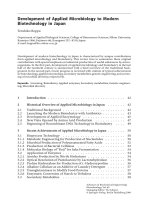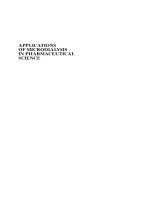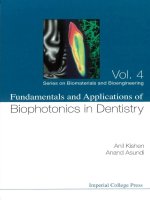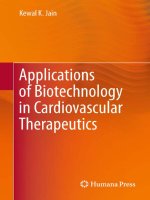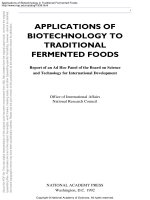applications of biotechnology in cardiovascular therapeutics
Bạn đang xem bản rút gọn của tài liệu. Xem và tải ngay bản đầy đủ của tài liệu tại đây (2.17 MB, 379 trang )
Applications of Biotechnology
in Cardiovascular Therapeutics
Applications
of Biotechnology
in Cardiovascular
Therapeutics
Kewal K. Jain MD, FRACS, FFPM
Jain PharmaBiotech, Basel, Switzerland
Kewal K. Jain
Jain PharmaBiotech
Blaesiring 7
Basel 4057
Switzerland
ISBN 978-1-61779-239-7 e-ISBN 978-1-61779-240-3
DOI 10.1007/978-1-61779-240-3
Springer New York Dordrecht Heidelberg London
Library of Congress Control Number: 2011931532
© Springer Science+Business Media, LLC 2011
All rights reserved. This work may not be translated or copied in whole or in part without the written
permission of the publisher (Humana Press, c/o Springer Science+Business Media, LLC, 233 Spring
Street, New York, NY 10013, USA), except for brief excerpts in connection with reviews or scholarly
analysis. Use in connection with any form of information storage and retrieval, electronic adaptation,
computer software, or by similar or dissimilar methodology now known or hereafter developed is
forbidden.
The use in this publication of trade names, trademarks, service marks, and similar terms, even if they
are not identified as such, is not to be taken as an expression of opinion as to whether or not they are
subject to proprietary rights.
Printed on acid-free paper
Humana press is part of Springer Science+Business Media (www.springer.com)
This book is dedicated to
Prof. Dr. Friedrich S. Eckstein,
Chief of Cardiac Surgery, Heart Center,
University Hospital Basel, who performed
the life-saving coronary artery bypass open
heart surgery with smooth recovery to enable
me to write this book. My thanks are due to
PD Dr. Michael Zellweger of the Cardiology
Department for competently conducting
diagnostic investigations including coronary
angiography and arranging treatment.
Finally, Prof. Dr. Michael Tamm and
PD Dr. Werner Strobel of the Pulmonology
Department referred me for cardiac
investigations after I presented with
nonspecific dyspnea. Having visited some
of the best medical centers in the world,
I am happy to say that the treatment that
I received in Basel was optimal and second
to none. I learned a fair bit about modern
cardiology during my interaction with
physicians at the hospital.
vii
Preface
This report puts together excerpts from the various writings by the author on the
biotechnology topics as they relate to cardiovascular disease. Very appropriately the
report was put together during the week that the author was recovering from open
heart bypass surgery at the University Hospital, Basel, Switzerland. It is meant for
physicians, surgeons, and scientists working on cardiovascular disorders. It will be
useful for those working in life sciences and pharmaceutical industries, and some
basics of cardiovascular diseases are included for nonmedical readers.
A major application of biotechnology is in therapeutic delivery to the cardiovas-
cular system. Routes of drug delivery and applications to various diseases are
described. Formulations for drug delivery to the cardiovascular system range from
controlled release preparations to delivery of proteins and peptides. Various methods
of improving systemic administration of drugs for cardiovascular disorders are
described including the use of nanotechnology.
Cell-selective-targeted drug delivery has emerged as one of the most significant
areas of biotechnology engineering research to optimize the therapeutic efficacy of
a drug by strictly localizing its pharmacological activity to a pathophysiologically
relevant tissue system. These concepts have been applied to targeted drug delivery
to the cardiovascular system. Finally, devices for drug delivery to the cardiovascular
system are described. A full chapter is devoted to drug-eluting stents used for treat-
ment of restenosis following stenting of coronary arteries. This is one of the biggest
segments of the cardiovascular drug delivery market with 15 companies involved in
developing and producing stents.
Cell and gene therapies, including antisense and RNA interference, are described
in full chapters as they are the most innovative methods of delivery of therapeutics.
New cell-based therapeutic strategies are being developed in response to the short-
comings of available treatments for heart disease. Potential repair by cell grafting or
mobilizing endogenous cells holds particular attraction in heart disease, where the
meager capacity for cardiomyocyte proliferation likely contributes to the irrevers-
ibility of heart failure. Cell therapy approaches include attempts to reinitiate cardio-
myocyte proliferation in the adult, conversion of fibroblasts to contractile myocytes,
viii Preface
conversion of bone marrow stem cells into cardiomyocytes, and transplantation of
myocytes or other cells into injured myocardium.
Advances in molecular pathophysiology of cardiovascular diseases have brought
gene therapy within the realm of possibility as a novel approach to treatment of
these diseases. It is hoped that gene therapy will be less expensive and affordable
because the techniques involved are simpler than those involved in cardiac bypass
surgery, heart transplantation, and stent implantation. Gene therapy would be a
more physiologic approach to deliver vasoprotective molecules to the site of vascular
lesion. Gene therapy is not only a sophisticated method of drug delivery; it may
also need drug delivery devices such as catheters for transfer of genes to various
parts of the cardiovascular system.
Finally, a chapter on personalized cardiology is important for the era of person-
alized medicine. This concept is the best way of integrating new technologies in
cardiology to select the best treatment for an individual patient.
The bibliography includes selected references from recent literature on this
topic, which are appended to each chapter. The text is supplemented by 22 tables
and 13 figures.
Kewal K. Jain, MD
Basel, Switzerland
ix
About This Book
This book contains excerpts from various biotechnology books and reports authored
by Prof. K. K. Jain that are relevant to cardiovascular disorders. The most important
contributions of biotechnology are to cardiovascular drug delivery. Advances in
cardiovascular surgery based on biomedical technology are beyond the scope of
this report. This is the draft of the expanded and updated document to be issued as
separate book.
xi
Professor Kewal K. Jain is a neurologist/neurosurgeon by training and since his
retirement from neurosurgery has been working in the biotechnology/biopharma-
ceuticals industry as a consultant at Jain PharmaBiotech. He received graduate
training in both Europe and North America and has held academic positions in
several other countries. He passed specialist examinations in neurosurgery in USA,
Canada, and Australia. Currently, he is a Fellow of the Royal Australasian College
of Surgeons and a Fellow of the Faculty of Pharmaceutical Medicine of the Royal
College of Physicians of UK. Prof. Jain is the author of 425 publications including
18 books (2 as editor) and 49 special reports, which have covered important areas
in neurosciences, biomedicine, biotechnology, cell/gene therapy, and biopharma-
ceuticals. In the 1970s, he developed a technique for sutureless microvascular
anastomosis using lasers described in his Handbook of Laser Neurosurgery pub-
lished by Charles C Thomas in 1984. His Textbook of Gene Therapy was translated
into Chinese language in 2000. The Textbook of Hyperbaric Medicine (5th Ed
2009) has been a standard reference on the subject for the past two decades and
contains a chapter on cardiovascular disorders.
Prof. Jain has edited Drug Delivery Systems (2008) and Drug Delivery to the
Central Nervous System (2010), both published by Humana/Springer. His other
recent books include Handbook of Nanomedicine (Springer/Humana 2008),
Textbook of Personalized Medicine (Springer 2009), Handbook of Biomarkers
(Springer 2010), and Handbook of Neuroprotection (Springer 2011).
About the Author
xiii
Contents
1 Cardiovascular Therapeutics 1
Introduction 1
History of Cardiovascular Therapy 1
Overview of Cardiovascular Disease 2
Epidemiology of Cardiovascular Disease 2
Management of Acute Coronary Occlusive Disease 3
Limitations of Current Therapies for Myocardial Ischemic Disease 3
Angina Pectoris 4
Cardiomyopathies 4
Cardiac Arrhythmias 5
Congestive Heart Failure 6
Peripheral Arterial Disease 6
Cholesterol and Atherosclerosis 7
Familial Hypercholesterolemia 7
The Endothelium as a Target for Cardiovascular Therapeutics 8
Molecular Cardiology 8
Cardiogenomics 9
Cardioproteomics 9
Ion Channels and the Cardiovascular System 13
Role of Plasminogen Activator Inhibitor-1
in the Cardiovascular System 16
Biotechnology and Therapy of Cardiovascular Diseases 16
Chronopharmacotherapy of Cardiovascular Diseases 17
Cardioprotection 18
Management of Ischemic/Reperfusion Injury to the Heart 20
Beta Blockers as Cardioprotectives 21
Cardioprotective Effects of Growth Hormone 22
Cardioprotection by Blocking Complement Activation 22
Cardioprotection by Resveratrol 22
HDL-Mediated Pharmaceutical Cardioprotection 23
Nicorandil for Cardioprotection 23
Statins for Cardioprotection in Dilated Cardiac Myopathy 24
xiv Contents
Role of Proteomics in Cardioprotection 24
Protection of the Blood Vessels 25
Important Advances in Cardiovascular Therapeutics 26
References 26
2 Drug Delivery to the Cardiovascular System 29
Introduction 29
Routes of Drug Delivery to the Cardiovascular System 29
Local Administration of Drugs to the Cardiovascular System 29
Intramyocardial Drug Delivery 29
Drug Delivery via Coronary Venous System 30
Intrapericardial Drug Delivery 31
Formulations for Drug Delivery to the Cardiovascular System 31
Sustained and Controlled Release 32
Methods of Administration of Proteins and Peptides 34
Targeted Drug Delivery to the Cardiovascular System 38
Immunotargeting of Liposomes to Activated Vascular
Endothelial Cells 38
PEGylated Biodegradable Particles Targeted
to Inflamed Endothelium 39
Devices for Cardiovascular Drug Delivery 40
Local Drug Delivery by Catheters 41
Micro-Infusion Catheters for Periarterial Injection 42
DDS in the Management of Ischemic Heart Disease 45
Drug Delivery for Cardiac Rhythm Disorders 47
Sustained and Controlled-Release Nitrate for Angina Pectoris 47
Vaccines Delivery for Hypertension 49
Drug Delivery in the Management of Pulmonary Hypertension 50
Anticoagulation in Cardiovascular Disease 51
Thrombolysis for Cardiovascular Disorders 53
Drug Delivery for Peripheral Arterial Disease 54
References 55
3 Role of Nitric Oxide in Cardiovascular Disorders 57
Introduction 57
Role of NO in Physiology of the Cardiovascular System 59
Hemoglobin, Oxygen, and Nitric Oxide 64
NO and Pulmonary Circulation 66
Role of NO in Pathomechanism of Cardiovascular Disorders 67
Oxidative Stress as a Cause of Cardiovascular Disease 67
Role of NO in Pathomechanism of Cardiovascular Diseases 67
NO and Atherosclerosis 70
Role of NO in Cardiopulmonary Disorders 71
Role of NO in Disturbances of Vasodilation 72
Role of NO in Hypercholesterolemia 72
xvContents
Pulmonary Hypertension 73
NO and Systemic Hypertension 74
Coronary Artery Disease 76
Role of NO in the Pathophysiology of Angina Pectoris 76
Role of NO in the Pathophysiology of Congestive Heart Failure 77
Myocardial Ischemia/Reperfusion Injury 78
Role of NO in Management of Cardiovascular Disorders 80
Role of NO in Cardioprotection 80
Role of NO in the Management of Angina Pectoris 81
Role of NO in Therapy of Coronary Heart Disease 82
NO-Releasing Aspirin in Patients Undergoing CABG 83
NO-Based Therapies for Congestive Heart Failure 83
NO-Based Therapy for Management of Cardiogenic Shock 84
NO-Based Therapy for Cardiac Arrhythmias 84
Prophylaxis of Cardiovascular Disorders 85
Peripheral Vascular Disorders 86
References 88
4 Biomarkers of Cardiovascular Disorders 91
Introduction 91
Biomarkers of Cardiovascular Diseases 92
Methods for Identification of Cardiovascular Biomarkers 94
Application of Proteomics for Biomarkers
of Cardiovascular Disease 94
Detection of Biomarkers of Myocardial Infarction
in Saliva by a Nanobiochip 94
Metabolomic Technologies for Biomarkers of Myocardial Ischemia 95
Imaging Biomarkers of Cardiovascular Disease 95
Applications of Biomarkers of Cardiovascular Disease 97
Biomarkers for Ischemic Heart Disease and Myocardial Infarction 97
Biomarkers of Congestive Heart Failure 103
Biomarkers for Atherosclerosis 108
Biomarkers of Risk Factors for Coronary Heart Disease 112
Biomarkers for Pulmonary Arterial Hypertension 114
Genetic Biomarkers for Cardiovascular Disease 116
Multiple Biomarkers for Prediction of Death
from Cardiovascular Disease 121
Role of Biomarkers in the Management of Cardiovascular Disease 122
Role of Biomarkers in the Diagnosis/Prognosis
of Myocardial Infarction 122
Role of Biomarkers in the Prevention of Cardiovascular Disease 122
Molecular Signature Analysis in Management
of Cardiovascular Diseases 123
C-Reactive Protein as Biomarker of Response to Statin Therapy 124
xvi Contents
Role of Circulating Biomarkers and Mediators
of Cardiovascular Dysfunction 125
Use of Protein Biomarkers for Monitoring Acute
Coronary Syndromes 125
Use of Biomarkers for Prognosis of Recurrent Atrial Fibrillation 126
Use of Multiple Biomarkers for Monitoring
of Cardiovascular Disease 126
Use of Biomarkers in the Management
of Peripheral Arterial Disease 127
Use of Biomarkers in the Management of Hypertension 127
Future Prospects for Cardiovascular Biomarkers 128
Cardiovascular Biomarker Consortium 128
Systems Approach to Biomarker Research
in Cardiovascular Disease 128
References 129
5 Molecular Diagnosis of Cardiovascular Disorders 133
Introduction 133
Basics of Molecular Diagnosis 133
Molecular Imaging of Cardiovascular Disorders 134
Genetic Cardiovascular Disorders 135
Coronary Heart Disease 135
Cardiomyopathy 136
Familial Hypertrophic Cardiomyopathy 136
Idiopathic Dilated Cardiomyopathy 137
Cardiac Arrhythmias 137
Long Q-T Syndrome 137
Familial Atrial Fibrillation 138
Idiopathic Ventricular Fibrillation 138
Early Detection of Congestive Heart Failure 139
Genetic Testing in Hypertension 139
Gene Mutations and Disturbances of Blood Lipids 140
Familial Dyslipoproteinemias 140
Hypercholesterolemia 140
Gene Mutations Associated with Thrombotic Disorders 141
Factor V Leiden Mutation 141
Pulmonary Embolism 142
Companies Involved in Cardiovascular Molecular Diagnosis 142
References 144
6 Nanobiotechnology in Cardiovascular Disorders 145
Introduction 145
Nanotechnology-Based Cardiovascular Diagnosis 146
Nanobiotechnology for Molecular Diagnostics 146
Nanosensors 147
xviiContents
Use of Magnetic Nanoparticles as MRI Contrast Agents
for Cardiac Disorders 148
Use of Perfluorocarbon Nanoparticles in Cardiovascular Disorders 148
Cardiac Monitoring in Sleep Apnea 148
Detection and Treatment of Atherosclerotic Plaques in the Arteries 149
Monitoring for Disorders of Blood Coagulation 149
Nanotechnology-Based Therapeutics for Cardiovascular Diseases 150
Nanolipoblockers for Atherosclerotic Arterial Plaques 150
Nanotechnology-Based Drug Delivery in Cardiovascular Diseases 150
Antirestenosis Drugs Encapsulated in Biodegradable Nanoparticles 152
Controlled Delivery of Nanoparticles to Injured Vasculature 152
IGF-1 Delivery by Nanofibers to Improve Cell Therapy
for Myocardial Infarction 152
Injectable Peptide Nanofibers for Myocardial Ischemia 153
Liposomal Nanodevices for Targeted Cardiovascular Drug Delivery 153
Low Molecular Weight Heparin-Loaded Polymeric Nanoparticles 154
Nanoparticles for Cardiovascular Imaging
and Targeted Drug Delivery 154
Nanofiber-Based Scaffolds with Drug-Release Properties 155
Nanotechnology Approach to the Vulnerable Plaque as Cause
of Cardiac Arrest 155
Nanotechnology for Regeneration of the Cardiovascular System 156
References 157
7 Cell Therapy for Cardiovascular Disorders 159
Introduction 159
Types of Cell Therapy for Cardiovascular Disorders 159
Cell-Mediated Immune Modulation for Chronic Heart Disease 160
Human Cardiovascular Progenitor Cells 161
Inducing the Proliferation of Cardiomyocytes 162
Role of the SDF-1-CXCR4 Axis in Stem Cell Therapies
for Myocardial Ischemia 163
Role of Splenic Myocytes in Repair of the Injured Heart 163
Reprogramming of Fibroblasts into Functional Cardiomyocytes 164
Small Molecules to Enhance Myocardial Repair by Stem Cells 164
Cell Therapy for Atherosclerotic Coronary Artery Disease 165
MyoCell
TM
(Bioheart) 165
Cardiac Stem Cells 166
Cardiomyocytes Derived from Epicardium 167
Methods of Delivery of Cells to the Heart 168
Cellular Cardiomyoplasty 168
IGF-1 Delivery by Nanofibers to Improve Cell Therapy for MI 168
Noninvasive Delivery of Cells to the Heart
by Morph
®
guide Catheter 169
Cell Therapy for Cardiac Revascularization 169
xviii Contents
Transplantation of Cardiac Progenitor Cells for Revascularization
of Myocardium 169
Stem Cells to Prevent Restenosis After Coronary Angioplasty 170
Role of Cells in Cardiac Tissue Repair 171
Modulation of Cardiac Macrophages for Repair of Infarct 171
Transplantation of Myoblasts for Myocardial Infarction 171
Patching Myocardial Infarction with Fibroblast Culture 172
Cardiac Repair with Myoendothelial Cells from Skeletal Muscle 173
Myocardial Tissue Engineering 173
Role of Stem Cells in Repair of the Heart 175
Role of Stem Cells in Cardiac Regeneration Following Injury 175
Cardiomyocytes Derived from Adult Skin Cells 175
Cardiomyocytes Derived from ESCs 176
Studies to Identify Subsets of Progenitor Cells Suitable
for Cardiac Repair 176
Technologies for Preparation of Stem Cells
for Cardiovascular Therapy 178
Role of ESCs in Repair of the Heart 180
Transplantation of Stem Cells for Acute Myocardial Infarction 181
Stem Cell Therapy for Cardiac Regeneration 188
Transplantation of Genetically Modified Cells 191
Transplantation of Genetically Modified MSCs 191
Transplantation of Cells Secreting Vascular Endothelial
Growth Factor 191
Transplantation of Genetically Modified Bone Marrow
Stem Cells 192
Cell Transplantation for Congestive Heart Failure 192
Myoblasts for Treatment of Congestive Heart Failure 193
Injection of Adult Stem Cells for Congestive Heart Failure 193
AngioCell Gene Therapy for Congestive Heart Failure 194
Stem Cell Therapy for Dilated Cardiac Myopathy 195
Role of Cell Therapy in Cardiac Arrhythmias 196
Atrioventricular Conduction Block 196
Ventricular Tachycardia 198
Prevention of Myoblast-Induced Arrhythmias
by Genetic Engineering 198
ESCs for Correction of Congenital Heart Defects 199
Cardiac Progenitors Cells for Treatment of Heart Disease 199
Autologous Stem Cells for Chronic Myocardial Ischemia 200
Role of Cells in Cardiovascular Tissue Engineering 201
Construction of Blood Vessels with Cells 201
Targeted Delivery of Endothelial Progenitor Cells Labeled
with Nanoparticles 202
Fetal Cardiomyocytes Seeding in Tissue-Engineered Cardiac Grafts 202
UCB Progenitor Cells for Engineering Heart Valves 202
Cell Therapy for Peripheral Vascular Disease 203
xixContents
ALD-301 203
Cell/Gene Therapy for PVD 203
Colony Stimulating Factors for Enhancing Peripheral
Blood Stem Cells 204
Intramuscular Autologous Bone Marrow Cells 204
Vascular Repair Cell 205
Clinical Trials of Cell Therapy in Cardiovascular Disease 205
Mechanism of the Benefit of Cell Therapy for Heart Disease 211
A Critical Evaluation of Cell Therapy for Heart Disease 211
Current Status of Cell Therapy for Cardiovascular Disease 212
Future Directions for Cell Therapy of CVD 212
Prospects of Adult Stem Cell Therapy for Repair of Heart 213
Regeneration of Cardiomyocytes Without Use
of Cardiac Stem Cells 214
References 214
8 Gene Therapy for Cardiovascular Disorders 219
Introduction 219
Techniques of Gene Transfer to the Cardiovascular System 220
Direct Plasmid Injection into the Myocardium 220
Catheter-Based Systems for Vector Delivery 221
Ultrasound Microbubbles for Cardiovascular Gene Delivery 221
Vectors for Cardiovascular Gene Therapy 221
Hypoxia-Regulated Gene Therapy for Myocardial Ischemia 224
Angiogenesis and Gene Therapy of Ischemic Disorders 225
Therapeutic Angiogenesis with Vascular Endothelial Growth
Factor Therapy 226
Gene Painting for Delivery of Targeted Gene Therapy to the Heart 226
Gene Delivery to Vascular Endothelium 227
Targeted Plasmid DNA Delivery to the Cardiovascular System
with Nanoparticles 227
Gene Therapy for Genetic Cardiovascular Disorders 229
Genetic Disorders Predisposing to Atherosclerosis 229
Gene Therapy of Familial Hypercholesterolemia 229
Apolipoprotein E Deficiency 231
Hypertension 232
Genetic Factors for Myocardial Infarction 233
Gene Therapy for Acquired Cardiovascular Diseases 233
Coronary Artery Disease with Angina Pectoris 233
Gene Therapy for Improving Long-Term CABG Patency Rates 234
Ischemic Heart Disease with Myocardial Infarction 234
Congestive Heart Failure 237
Gene Therapy for Cardiac Arrhythmias 240
Gene Therapy and Heart Transplantation 242
Gene Therapy for Peripheral Arterial Disease 243
xx Contents
Maintaining Vascular Patency After Surgery 245
Antisense Therapy for Cardiovascular Disorders 245
Antisense Therapy for Hypertension 246
Antisense Therapy for Hypercholesterolemia 247
Antisense Therapy for Preventing Occlusion of Venous Grafts
in CABG 248
RNAi for Cardiovascular Disorders 248
RNAi for Hypercholesterolemia 249
microRNA and the Cardiovascular System 250
Future Prospects of Gene Therapy of Cardiovascular Disorders 253
Companies Involved in Gene Therapy of Cardiovascular Disorders 255
References 256
9 Coronary Angioplasty and Drug-Eluting Stents 259
Introduction 259
Percutaneous Transluminal Coronary Angioplasty 259
Stents 260
Restenosis 260
Pathomechanism 261
Treatment 262
Role of NO in the Management of Coronary Restenosis 262
Carbon Monoxide Inhalation for Preventing Restenosis 264
Antisense Approaches for Prevention
of Restenosis After Angioplasty 265
miRNA-Based Approach for Restenosis Following Angioplasty 265
Gene Therapy to Prevent Restenosis After Angioplasty 266
Drug Delivery Devices for Restenosis 269
Local Drug Delivery by Catheter 270
Absorbable Metal Stents 270
Drug-Eluting Stents 271
Various Types of DES 271
Novel Technologies for DES 274
Nanotechnology-Based Stents 278
Restenosis After Percutaneous Coronary Angioplasty 278
The Ideal DES 282
Companies Developing Drug-Eluting Stents 283
Clinical Trials of Drug-Eluting Stents 284
Comparison of DES with Competing Technologies 291
Cost-Effectiveness of DES 297
Safety Issues of DES 298
Regulatory Issues of DES 303
Future Prospects for Treatment of Restenosis by DES 305
Future Role of DES in Management of Cardiovascular Diseases 305
Stent Cost and Marketing Strategies 306
xxiContents
Improvements in Stent Technology 307
DES Versus Drug-Eluting Balloons 308
References 308
10 Personalized Cardiology 315
Introduction to Personalized Medicine 315
Role of Diagnostics in Personalized Management
of Cardiovascular Disease 316
Testing in Coronary Heart Disease 316
SNP Genotyping in Cardiovascular Disorders 316
Cardiovascular Disorders with a Genetic Component 317
Gene Variant as a Risk Factor for Sudden Cardiac Death 318
KIF6 Gene Test as a Guide to Management of Congestive
Heart Failure 320
SNP Chip for Study of Cardiovascular Diseases 321
Pharmacogenomics of Cardiovascular Disorders 321
Modifying the Genetic Risk for Myocardial Infarction 321
Management of Heart Failure 322
b -Blockers 322
Bucindolol 323
BiDil 323
Management of Hypertension 324
Pharmacogenomics of Diuretic Drugs 324
Pharmacogenomics of ACE Inhibitors 325
Management of Hypertension by Personalized Approach 326
Prediction of Antihypertensive Activity of Rostafuroxin 327
Pharmacogenetics of Lipid-Lowering Therapies 328
Polymorphisms in Genes Involved in Cholesterol Metabolism 328
Role of eNOS Gene Polymorphisms 329
The STRENGTH Study 330
Personalized Management of Women with Hyperlipidemia 331
Thrombotic Disorders 331
Factor V Leiden Mutation 332
Anticoagulant Therapy 332
Antiplatelet Therapy 333
Nanotechnology-Based Personalized Therapy of
Cardiovascular Diseases 333
Project euHeart for Personalized Management of Heart Disease 334
Concluding Remarks 335
References 335
Index 337
xxiii
Fig. 1.1 Biotechnology and therapy of cardiovascular diseases 17
Fig. 2.1 Bullfrog
®
Micro-Infusion catheter for peripheral artery injection.
Illustrations courtesy of Mercator MedSystems 42
Fig. 2.2 Cricket
®
Micro-Infusion catheter for coronary artery injection.
A single injection to the outside of the vessel results in liquid
compounds diffusing around the vessel (circumferentially),
up and down the vessel (longitudinally), and inward through
the vessel layers (transmurally). The microscopic needle
puncture is so small that it heals almost instantly.
Illustrations courtesy of Mercator MedSystems 43
Fig. 3.1 Biosynthesis of nitric oxide (NO). L-arginine is converted
to NO in two successive steps of which a two-electron
oxidation of L-arginine to N-w-hydroxy-L-argininine
is the first, then converted to NO and citrulline, utilizing
one and half NADPH and O
2
. Both steps require Ca
2+
and calmodulin as activators and are accelerated by
tetrahydrobiopterin (©Jain PharmaBiotech) 58
Fig. 3.2 Role of NOS in functions of the cardiac myocyte.
Postsynaptically, acetylcholine (Ach) binds to ACh receptors
(M2) on the sinoatrial-node pacemaker cells and,
via second messenger pathways, modulates ion channels to
reduce heart rate. NO is generated in the pacemaker cell
following M2-receptor activation via caveolin-3 and eNOS
to inhibit flow of Ca
2+
through L-type Ca channels.
When noradrenalin binds to the b1-adrenoceptor, nNOS
localized in the sarcoplasmic reticulum can regulate
Ca
2+
fluxes via SR-Ca
2+
ATPase (SERCA), Ca
L
and
ryanodine-sensitive Ca
2+
release channels (CRC)] to
minimize the effect of excessive sympathetic stimulation.
List of Figures
xxiv List of Figures
AC adenylate cyclase, PKA protein kinase A, PKG protein
kinase G, PDE2 phosphodiesterase 2, sGC soluble
guanylate cyclase 61
Fig. 3.3 Blood cell–endothelial cell interactions induced by
hypercholesterolemia. The interactions are modulated
by both NO (produced by eNOS) and O
2
, which is
produced by multiple sources including hypoxanthine
(HX) via xanthine oxidase (XO) in endothelial cells
and NAD (P) Hox in both leukocytes and endothelial cells 73
Fig. 3.4 Effects of NO on the pathophysiology of myocardial
ischemia-reperfusion. PMN polymorphonuclear leukocyte,
RNOS reactive NO species, ROS reactive O
2
species 79
Fig. 7.1 hESC-derived cardiomyocytes from laboratory to bedside 177
Fig. 9.1 Myocardial infarction following procedures on
coronary arteries 260
Fig. 9.2 Vicious circle of vascular occlusion following angioplasty
and stenting 263
Fig. 9.3 Medtronic’s Endeavor Sprint Zotarolimus-Eluting
Coronary Stent System 277
Fig. 9.4 Magnetic nanoparticle-coated stent 280
Fig. 10.1 A scheme of personalized approach to
management of hypertension 326
